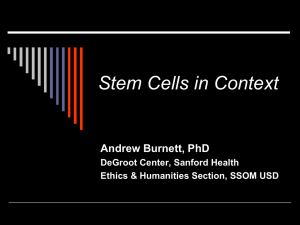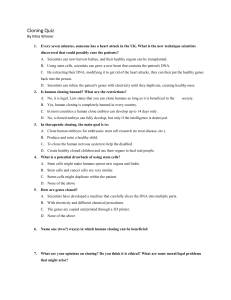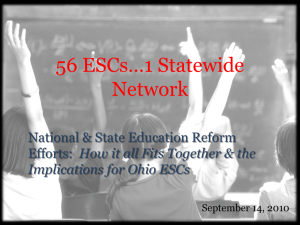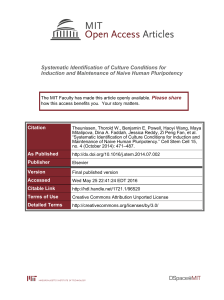Stem cells - MyBelovedScientists
advertisement
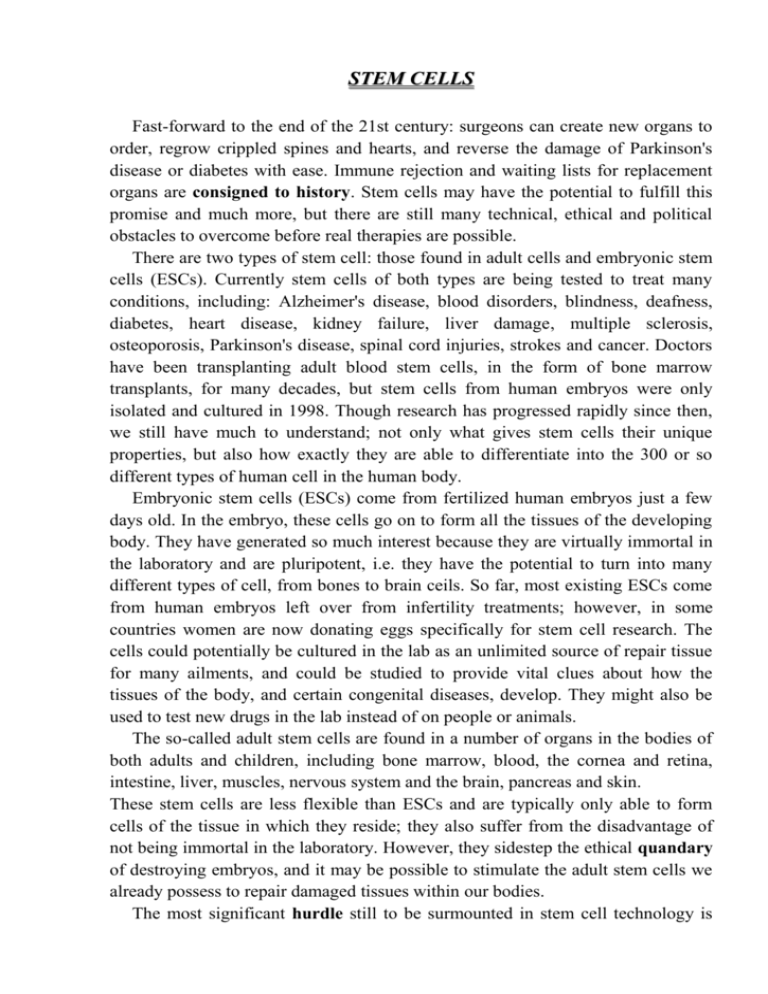
STEM CELLS Fast-forward to the end of the 21st century: surgeons can create new organs to order, regrow crippled spines and hearts, and reverse the damage of Parkinson's disease or diabetes with ease. Immune rejection and waiting lists for replacement organs are consigned to history. Stem cells may have the potential to fulfill this promise and much more, but there are still many technical, ethical and political obstacles to overcome before real therapies are possible. There are two types of stem cell: those found in adult cells and embryonic stem cells (ESCs). Currently stem cells of both types are being tested to treat many conditions, including: Alzheimer's disease, blood disorders, blindness, deafness, diabetes, heart disease, kidney failure, liver damage, multiple sclerosis, osteoporosis, Parkinson's disease, spinal cord injuries, strokes and cancer. Doctors have been transplanting adult blood stem cells, in the form of bone marrow transplants, for many decades, but stem cells from human embryos were only isolated and cultured in 1998. Though research has progressed rapidly since then, we still have much to understand; not only what gives stem cells their unique properties, but also how exactly they are able to differentiate into the 300 or so different types of human cell in the human body. Embryonic stem cells (ESCs) come from fertilized human embryos just a few days old. In the embryo, these cells go on to form all the tissues of the developing body. They have generated so much interest because they are virtually immortal in the laboratory and are pluripotent, i.e. they have the potential to turn into many different types of cell, from bones to brain ceils. So far, most existing ESCs come from human embryos left over from infertility treatments; however, in some countries women are now donating eggs specifically for stem cell research. The cells could potentially be cultured in the lab as an unlimited source of repair tissue for many ailments, and could be studied to provide vital clues about how the tissues of the body, and certain congenital diseases, develop. They might also be used to test new drugs in the lab instead of on people or animals. The so-called adult stem cells are found in a number of organs in the bodies of both adults and children, including bone marrow, blood, the cornea and retina, intestine, liver, muscles, nervous system and the brain, pancreas and skin. These stem cells are less flexible than ESCs and are typically only able to form cells of the tissue in which they reside; they also suffer from the disadvantage of not being immortal in the laboratory. However, they sidestep the ethical quandary of destroying embryos, and it may be possible to stimulate the adult stem cells we already possess to repair damaged tissues within our bodies. The most significant hurdle still to be surmounted in stem cell technology is immune rejection. As with any tissue transplant (from a donor other than an identical twin), the body will recognize ESCs as foreign and mount an attack which could destroy them. Therapeutic cloning is a clever technique that circumvents this problem. Custom-made ESCs, formed from a patient's own DNA and a donor egg, contain the DNA of the recipient and would not be treated as foreign by the immune system. However, the cloned embryo could in theory be implanted into a womb where it might develop into a cloned human baby. This would be reproductive cloning, and is the same method that was used to produce Dolly the sheep, the world's first successfully cloned animal. Producing viable clones of many species is a lengthy and difficult problem and, despite questionable claims of success, has yet to be proven in humans. In any case, reproductive cloning has been banned in many European countries for ethical reasons and because of suspected health risks to the clone. Opponents argue that all embryos, whether created in the lab or not, have the potential to go on to become a fully-fledged human, and therefore it is morally wrong to experiment on them. Other countries have taken the line that the medical benefits outweigh these concerns, and therapeutic cloning has been allowed, although subject to strict regulation. In the United States, disagreement between the religious groups who want a total ban on cloning and an equally vociferous pro-therapeutic cloning lobby has currently stalled legislation on stem cell technology. Politics is not the only controversy that has dogged the stem cell world. In May 2005, one of the world's top stem cell scientists - South Korea's Woo Suk Hwang announced that his team had used therapeutic cloning to produce ESCs tailored to individual patients. This was one of a string of remarkable achievements. In 2004 Hwang cloned human embryos for the first time, and he later produced the world's first cloned dog - an Afghan hound named Snuppy. Then in late 2005, the research community was rocked by claims that much of his research had been fabricated. The repercussions travelled far and wide, and the already controversial field of stem cell research was brought further into disrepute. It remains to be seen how much the scandal will delay the development of the miracle therapies that are so desperately desired. 1. Match the words and phrases 1-8 to their definitions a-h. 1 2 3 4 cell clone DNA embryo 5 6 7 8 immune organ tissue transplant a) a part of your body that does a specific job, such as your heart or brain b) the smallest part of a living structure that can operate as an independent unit c) a medical operation in which a new organ is put into someone's body. The organ is taken from the body of another person, especially someone who has just died, who is called a donor. d) an animal or human before it is born, when it is beginning to develop and grow e) the substance that animal and plant cells are made of f) an exact copy of an animal or plant created in a laboratory from the animal's or plant's DNA g) safe from a disease, because you cannot be infected by it h) deoxyribonucleic acid: a chemical substance that contains genetic information and is found in all living cells and some viruses 2. Read the text and say where you think it comes from. 1 A research paper 3 A medical report 2 A scientific journal 4 A popular magazine 3. Choose the best titles a-g for the paragraphs 1-7. e Ethical minefield a Fall from grace f ESCs b The cloning connection g What are stem cells? c Adult stem cells d Miracle technology? 4. Choose the correct alternative. 1. The ESCs used in stem cell technology are produced a) naturally in the body. b)artificially in a laboratory. c) either naturally or artificially. 2. Scientists can stop the body rejecting transplanted tissue a) by using tissue from donors other than an identical twin. b)by using ESCs from a clone of the patient. c)by using an embryo from the patient. 3. Some people object to ESC technology because a) its benefits have not yet been proved. b)it is a lengthy process. c)it involves destroying embryos that are potential human beings. 4. Suk Kwang's work caused controversy amongst scientists because a) he did not tell the truth about his experiments. b) he produced the world's first cloned animal. c) he used ESCs to treat patients. 5. Match the words or phrases in bold in the text to the following synonyms 1-8: 1) able to survive 2) complete 3) dilemma 4) gets round 5) obsolete 6) obstacle 7) troubled 8) uncertain 6. Answer the following questions. 1. What are the types of stem cells? Which of them is widely used? Why? 2. What is the source of ESCs? Why have the stem cells generated so much interest? 3. How can ESCs be grown and used? 4. Where can the so-called adult stem cells be found? What is the main difference between them and ESCs? 5. What is the most significant hurdle which is still to be surmounted in stem cell technology? In what way? 6. What controversy exists in the society now? 7. What do you think?Choose the best option and prove your point of view in a few sentences. 1 Scientists should be free to develop ESC technology. 2 ESC technology should be banned. 3 ESC technology should be allowed, but subject to regulation.



